- Sailing Yachts
- Motor Boats
- Motor Yachts
- Power Catamarans
- Traditional Gulets
- Destinations
- {{ getLocationById(modelId).text }} {{ getLocationById(modelId).type }} ({{ getLocationById(modelId).count }}) Remove
- {{ locationModel.text }} {{ locationModel.type }} ({{ locationModel.count }})
- {{ model.text }}
{{ text.guests }}
- {{ location.text }} {{ location.type }} ({{ location.count }})
- {{model.text }}
{{ ('Guests') }}
- All Inclusive
- Motor yacht
- Sailing yachts
- Without License
- With License
- Full Batten
- Self tacking jib
- Air condition
- Bow thruster
- Chart plotter
- Electric winches
- Hydraulic gangway
- Radio-CD player
- Refrigerator

7 Waves Yachting

Sun Odyssey 440 | Rebelezza

Sun Odyssey 410 | Naoussa

| Bon Voyage
Prestige 460 | Perfect Life

Prestige 42 Fly | My Love II
About 7 Waves Yachting
7 Waves Yachting is a verified professional charter company offering high-quality luxury yachts in Spain. The company has 3 charter bases where clients can rent boats, the busiest of which are: Club Nautic S`Arenal, Marina Port de Mallorca, and Marina Palma Cuarentena. Whether you are looking for a catamaran, a motor boat, a sailing yachts, a motor yacht or an unforgettable experience, 7 Waves Yachting offers everything you need for your vacation. The company has an extensive fleet of 12 boats, with brands including Custom Manufacturer, Jeanneau, Lagoon and Sunseeker.
7 Waves Yachting offers both Crewed and Bareboat charters. Depending on their preferences, customers can rent a boat alone or with a professional crew. The company's address is Av de Gabriel Roca 27, Palma de Mallorca, Spain. 7 Waves Yachting is known for its high-quality services and professional attitude to its customers. The company is ready to answer any questions and provide customized solutions to meet the needs of each customer.
The ports where 7 Waves Yachting has bases
Countries where 7 waves yachting operates.
Get inspired beyond the blue horizon!
- Sailing Blog
- Work with Us
- Meet the Team
- Terms of use
- Privacy Policy
- Cancellation Policy
Copyright © 2020-2024 by COME ON BOARD OOD VAT: BG 205812655, 6, 6th September str. Sofia, Bulgaria
7 Waves Yachting yacht charter company
This fleet operator offers crewed and bareboat yachts for charter in the following countries: Spain - Mallorca. The main office of the company is located in Av de Gabriel Roca 36. Official name of the company is 7 Waves Yachting. On our web site you may check availability of their boats and make an on-line reservation. 7 Waves Yachting has the fleet of 6 boats and company can offer for charter the following yacht types: sailing yachts,powerboats
Customer reviews

- Bowthruster
- Furling mainsail
- Fully battened mainsail
- Electric toilet
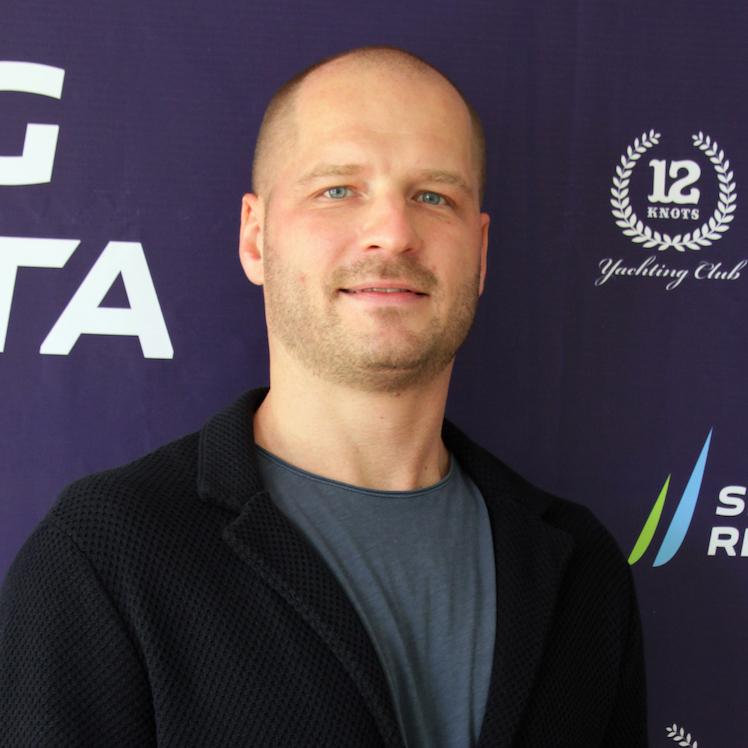
Need help? Call us:
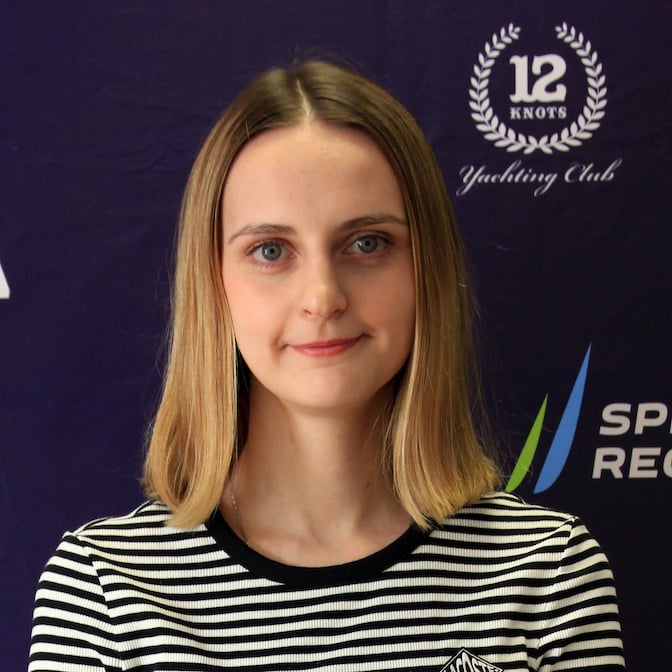
6 boats available from 6 in 7 Waves Yachting
Sun odyssey 440 sailboat charter (2019).
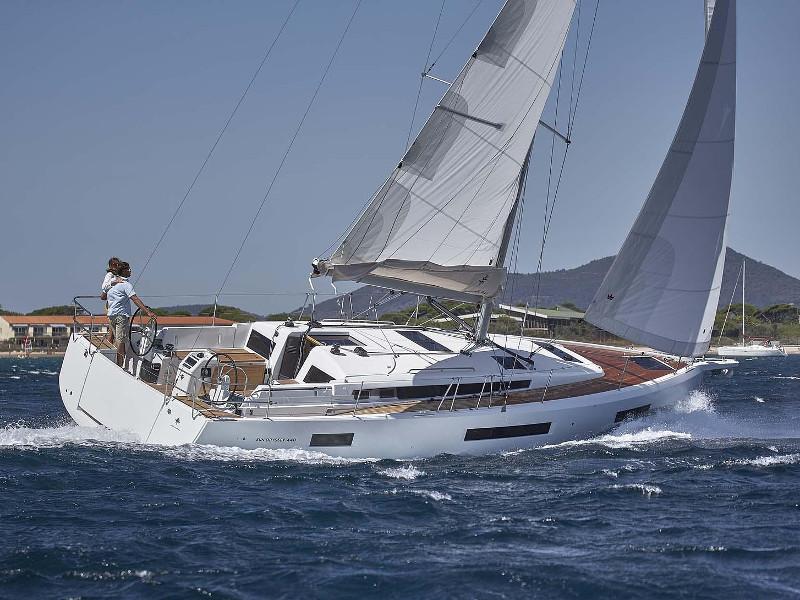
Rent a boat Sun Odyssey 410 (2022) in Spain - Mallorca
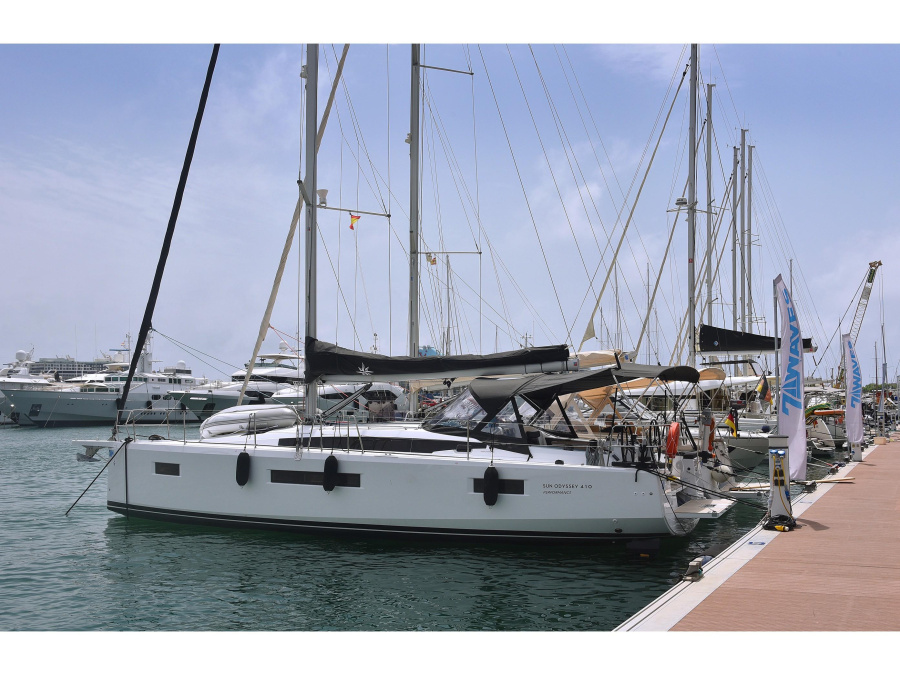
Power boat Prestige 420 New (2020) for rent in Spain - Mallorca
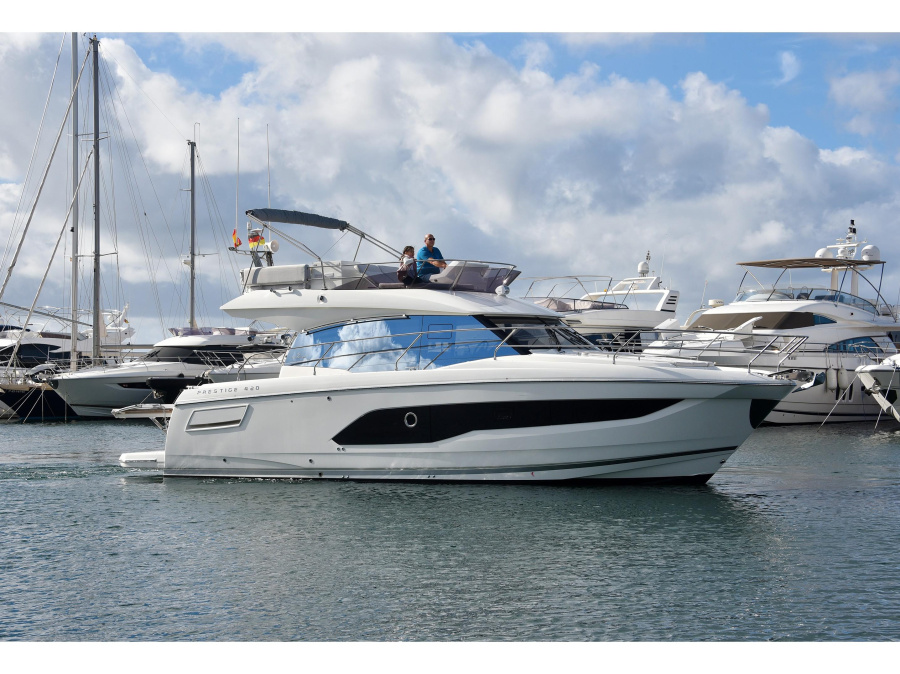
DB 43 power boat charter (2023)
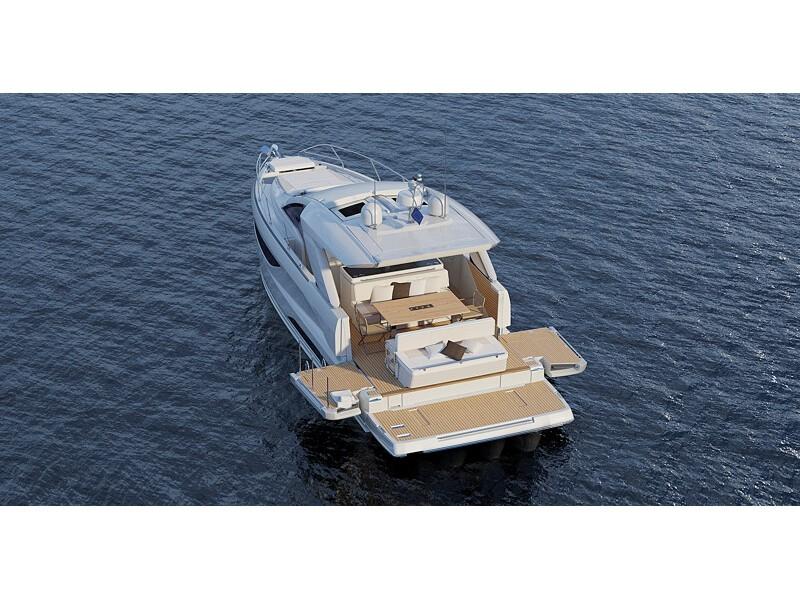
Rent a boat Prestige 460 (2021) in Spain - Mallorca
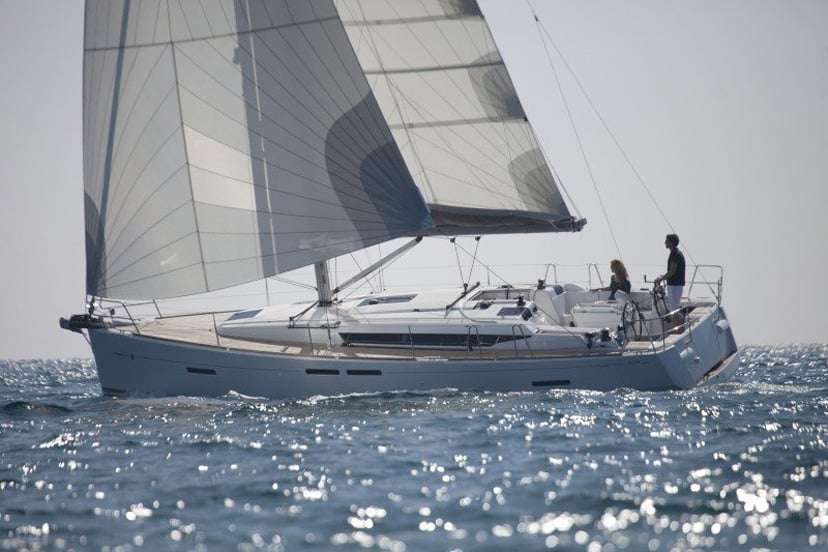
Power boat Prestige 630 Fly (2018) for rent in Spain - Mallorca

Write a review
Charter type, your personal data.
7 Waves Yachting
About the operator.
Its headquaters is in Iltisweg 4 Kaarst in Germany. They are registered under the name: 7 Waves Yachting. They offer yacht charters in Germany : Yacht charter Germany . Palma de Mallorca , Palma are the marinas where you can hire their sailing yachts. We advise you to come back to the home port on Friday afternoon till 16:00 in order to make a check-out of the yacht. Downpayment is 50% of charter price, second payment is to be paid 30 days before arrival. If you want to get the First Minute discounts, you should book a boat before 31.01 each year. Firm 7 Waves Yachting has won the appreciation of its clients.
- Name 7 Waves Yachting
- Address Av de Gabriel Roca 36, Spain
Bases where You can charter 7 Waves Yachting yachts
- Arenal, Balearics
- Marina Port de Mallorca, Balearics
- Marina Palma Cuarentena, Balearics
Yacht charter offers of 7 Waves Yachting (available online)
We've found the best deals for 6 yachts available
Selected offers from 7 Waves Yachting starting on 2024-06-01 for 1 week

4263€ 4350€ 2%
- Gps plotter
- Bow thruster
- Year of Build: 2022

4508€ 4600€ 2%
- Year of Build: 2019

8967€ 9150€ 2%
- Air conditioning
- Year of Build: 2020

12348€ 12600€ 2%
- Year of Build: 2023

12985€ 13250€ 2%
- Year of Build: 2021
- Furling mainsail
- Plotter gps in cockpit
- Possibility of deposit insurance

Mobile Menu Overlay
The White House 1600 Pennsylvania Ave NW Washington, DC 20500
Statement from President Joe Biden on $7.7 Billion in Student Debt Cancellation for 160,000 Borrowers
Today, my Administration is canceling student debt for 160,000 more people, bringing the total number of Americans who have benefitted from our debt relief actions to 4.75 million. Each of those borrowers has received an average of over $35,000 in debt cancellation. These 160,000 additional borrowers are people enrolled in my Administration’s SAVE Plan; are public service workers like teachers, nurses, or law enforcement officials; or are borrowers who were approved for relief because of fixes we made to Income-Driven Repayment.
Today’s announcement comes on top of the significant progress we’ve made for students and borrowers over the past three years. That includes providing the largest increases to the maximum Pell Grant in over a decade; fixing Public Service Loan Forgiveness so teachers, nurses, police officers, and other public service workers get the relief they are entitled to under the law; and holding colleges accountable for taking advantage of students and families. And last month, I laid out my Administration’s new plans that would cancel student debt for more than 30 million Americans when combined with everything we’ve done so far.
From day one of my Administration, I promised to fight to ensure higher education is a ticket to the middle class, not a barrier to opportunity. I will never stop working to cancel student debt – no matter how many times Republican elected officials try to stop us.
Stay Connected
We'll be in touch with the latest information on how President Biden and his administration are working for the American people, as well as ways you can get involved and help our country build back better.
Opt in to send and receive text messages from President Biden.

+++ Keine Stornogebühren und kostenloses Umbuchen für alle Charterbuchungen, die von COVID 19 betroffen sind.+++
Bitte schreiben sie uns wie wir sie unterstützen können, ihre nachricht an uns / ihre buchungsanfrage.
Thank you for visiting nature.com. You are using a browser version with limited support for CSS. To obtain the best experience, we recommend you use a more up to date browser (or turn off compatibility mode in Internet Explorer). In the meantime, to ensure continued support, we are displaying the site without styles and JavaScript.
- View all journals
- My Account Login
- Explore content
- About the journal
- Publish with us
- Sign up for alerts
- Open access
- Published: 25 May 2024
Inhomogeneous high temperature melting and decoupling of charge density waves in spin-triplet superconductor UTe 2
- Alexander LaFleur 1 na1 ,
- Hong Li ORCID: orcid.org/0000-0001-8810-1989 1 na1 ,
- Corey E. Frank 2 ,
- Muxian Xu 1 ,
- Siyu Cheng ORCID: orcid.org/0009-0000-7825-9379 1 ,
- Ziqiang Wang ORCID: orcid.org/0000-0001-7617-2886 1 ,
- Nicholas P. Butch 2 , 3 &
- Ilija Zeljkovic ORCID: orcid.org/0000-0001-9966-2140 1
Nature Communications volume 15 , Article number: 4456 ( 2024 ) Cite this article
182 Accesses
2 Altmetric
Metrics details
- Condensed-matter physics
- Electronic properties and materials
- Superconducting properties and materials
Charge, spin and Cooper-pair density waves have now been widely detected in exotic superconductors. Understanding how these density waves emerge — and become suppressed by external parameters — is a key research direction in condensed matter physics. Here we study the temperature and magnetic-field evolution of charge density waves in the rare spin-triplet superconductor candidate UTe 2 using scanning tunneling microscopy/spectroscopy. We reveal that charge modulations composed of three different wave vectors gradually weaken in a spatially inhomogeneous manner, while persisting to surprisingly high temperatures of 10–12 K. We also reveal an unexpected decoupling of the three-component charge density wave state. Our observations match closely to the temperature scale potentially related to short-range magnetic correlations, providing a possible connection between density waves observed by surface probes and intrinsic bulk features. Importantly, charge density wave modulations become suppressed with magnetic field both below and above superconducting T c in a comparable manner. Our work points towards an intimate connection between hidden magnetic correlations and the origin of the unusual charge density waves in UTe 2 .
Similar content being viewed by others
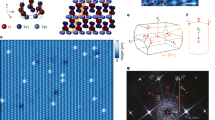
Magnetic-field-sensitive charge density waves in the superconductor UTe2
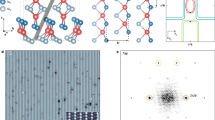
Detection of a pair density wave state in UTe2
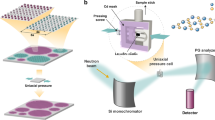

Single-domain stripe order in a high-temperature superconductor
Introduction.
Unconventional superconductivity often occurs in close proximity to other symmetry-breaking phases. In the canonical example of cuprate superconductors, superconductivity is found to co-exist with electronic nematic phase, which breaks the rotation symmetry of the system, and the periodic modulations, or waves, of the charge density and the superfluid density throughout much of the phase diagram 1 . The Cooper pair density waves (PDWs), either as the primary drivers or as secondary states accompanying charge density waves (CDWs), have now been seen in a range of unconventional superconductors, including cuprate high-temperature superconductors 2 , 3 , 4 , Fe-based superconductors 5 , 6 and kagome superconductors 7 , 8 , 9 .
Out of the array of density wave superconductors, heavy fermion superconductor UTe 2 is an intriguing example of a system that also shows strong evidence for spin-triplet superconductivity in proximity to an underlying magnetic instability 10 , 11 and strong fluctuations 12 , 13 , 14 , 15 . Unconventional pairing is supported by the very small Knight shift change across the bulk superconducting transition temperature T c 10 , 16 , large and highly anisotropic critical magnetic fields 10 , peculiar phase diagram with multiple superconducting regimes 17 and the non-zero polar Kerr effect below T c 12 signaling time-reversal symmetry breaking despite the absence of long-range magnetic order 10 . Within this superconducting state, the system is also reported to host intertwined Cooper pair and charge density wave modulations 18 , 19 , further highlighting the unusual nature of this superconductor. Revealing how these phases emerge as the temperature is lowered, or how they are suppressed by perturbations such as magnetic field or chemical doping can provide an essential insight into their nature. In particular, understanding the CDW transition and how large the CDW onset temperature is, can be crucial for unveiling the nature of the PDW and whether it is a primary PDW.
Here we use spectroscopic imaging scanning tunneling microscopy (SI-STM) to discover an unusual nature of the CDW in UTe 2 . By investigating the evolution of charge modulations in UTe 2 as a function of temperature and magnetic field, we find that the CDW phase emerges substantially above the superconducting transition, at about 10-12 K. SI-STM spatial mapping reveals that the CDW phase is suppressed by forming short-range CDW regions that shrink in size as the CDW approaches global suppression by increasing the temperature. The arrangement of CDW puddles is reproducible with repeated thermal or field cycles, pointing towards the role of local disorder. Interestingly, based on the temperature and energy-dependence, we discover one of the density wave vectors along the mirror symmetry direction is distinct compared to the other two. This reveals an unexpected decoupling of the three-component CDW state. Importantly, the onset temperature of charge modulations observed here closely matches the temperature scale in transport measurements believed to be associated with magnetic correlations, providing a possible connection relating the density waves observed by surface sensitive experiments and bulk measurements. Importantly, we discover that magnetic field gradually suppresses the charge density wave even at temperatures several times higher than the superconducting T c . Such primary CDWs tunable by magnetic field are very rare. Given UTe 2 as a spin-triplet superconductor, our work suggests that spin-triplet superconductivity in UTe 2 emerges from an unusual charge density wave state connected to “hidden” magnetic correlations as its origin.
We study bulk single crystals of UTe 2 with bulk superconducting T SC ≈ 1.6 K 10 (Methods). We cleave the crystals in ultra-high-vacuum at liquid nitrogen temperature, and immediately insert them into the microscope head. The crystal structure of UTe 2 is orthorhombic and UTe 2 crystals tends to cleave along the [0 − 11] direction 20 . Typical STM topographs of the (0 − 11) plane show a chain-like surface, with two rows of Te atoms oriented along the [100] direction (Fig. 1a ), similarly to what has been observed in other STM studies 18 , 19 , 20 . In addition to the atomic Bragg peaks Q Bragg and Te chain Bragg peaks Q chain (Fig. 1b ), Fourier transforms (FTs) of differential conductance d I /d V maps show three other pairs of peaks (Fig. 1c, d ). These peaks are non-dispersive with energy (Fig. 1e–g ) and correspond to an emergent charge density wave (CDW) intertwined with a PDW at the same wave vectors 18 , 19 .
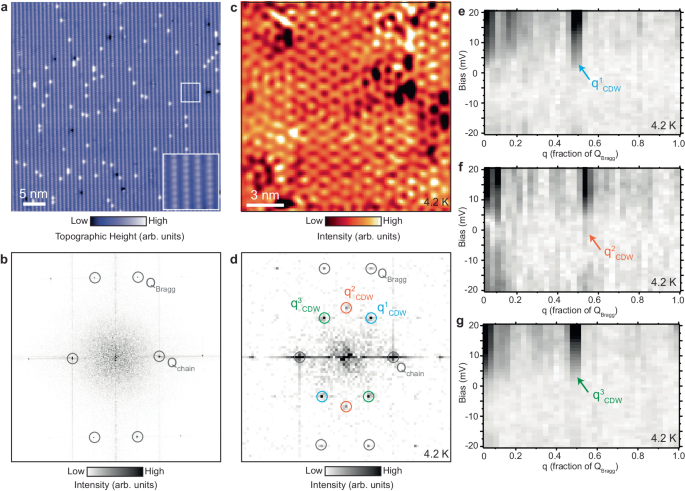
a Atomically-resolved scanning tunneling microscopy (STM) topograph of UTe 2 (0 − 11) surface with bright rows of Te atoms positioned along the crystal a -axis. Inset in (a) shows the zoomed-in topograph over the small white square. b Fourier transform (FT) of the STM topograph in (a). Te Bragg peaks (Q Bragg ) and the unidirectional chain peaks (Q chain ) are circled. c Fourier filtered single-layer d I /d V map on the same UTe 2 (0–11) surface showing the characteristic charge density wave (CDW) pattern, and ( d ) its associated FT. Three different CDW peaks q 1 CDW , q 2 CDW , and q 3 CDW are circled in the FT in ( d ) in blue, red and green, respectively. e–g FT linecuts, starting from the center of the FT through each of the three CDW peaks, as a function of energy. It can be seen that the position of the three CDW peaks is not dependent on energy. STM setup condition: V sample = −20 mV, I set = 100 pA ( a ); V sample = 20 mV, I set = 40 pA, V exc = 3 mV ( c ); V sample = −20 mV, I set = 40 pA, V exc = 3 mV ( e – g ).
Previous STM experiments primarily focused on studying these density waves in the superconducting state, and reported their existence up to at least 4.2 K 18 , 19 . Consistent with these, CDW peaks in our data are also clearly detectable at 4.2 K (Fig. 1d ). We proceed to investigate how the CDW state disappears, first exploring the effect of increasing the temperature. We measure and compare d I /d V maps as a function of temperature over an identical area of the sample, acquired under the same experimental conditions (Fig. 2a–d ). To quantitatively evaluate the evolution of the CDW phase, we extract FT linecuts from the center of the FT through each of the three CDW peaks at every temperature measured (Fig. 2a–c ). It can be seen that peaks get progressively suppressed with temperature. At maximum temperature used in this experiment sequence of 7.4 K, which is about five times higher than the superconducting T SC , the peaks are still easily discernable above the background. By plotting the heights of the peaks as a function of temperature, normalized by the FT background signal (Fig. 2d ), we estimate the CDW onset temperature T CDW to be about 10 K. This is further confirmed by the data on the second sample, where we can see that CDW peaks are largely suppressed at 10 K, with only q 2 CDW still visible (Fig. 2e–m ), which we will discuss in more detail in subsequent paragraphs.
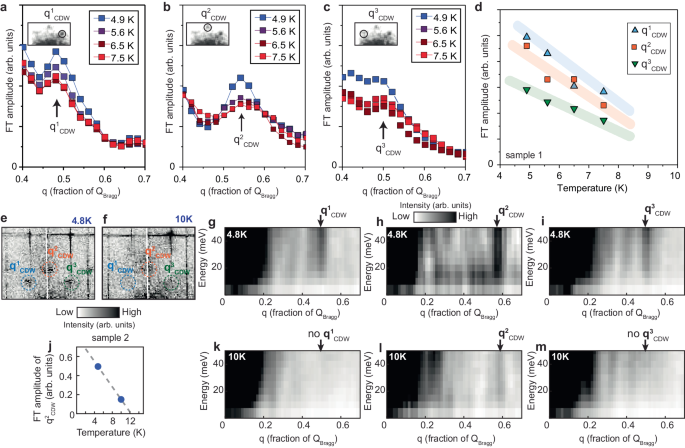
a – c Fourier transform (FT) linecuts of the d I /d V map acquired at 40 mV, starting from the center of the FT, through the three CDW peaks: ( a ) q 1 CDW , ( b ) q 2 CDW , and ( c ) q 3 CDW on sample 1. Suppression of the CDW peaks is apparent with increasing temperature. Insets in ( a – c ) show the relevant portion of the FT, with the corresponding wave vector that is plotted circled. d Plot of the background-subtracted height (FT amplitude) of the Gaussian fits to each peak in the temperature-dependent linecuts in ( a – c ). Blue, red and green lines represent linear visual guides for each of the three CDW peak amplitude dispersions, which seem to approach zero amplitude at about 10 K. e , f FT of d I /d V map acquired at 50 mV on sample 2 at ( e ) 4.8 K and ( f ) 10 K (same scale used for both). The positions of three CDW peaks are circled. g – i FT linecuts, starting from the center of the FT through each of the three CDW peaks, as a function of energy at 4.8 K. j Linear fit of FT peak height of q 2 CDW as a function of temperature extracted from ( e , f ). k – m FT linecuts, starting from the center of the FT through each of the three CDW peaks, as a function of energy at 10 K. q 1 CDW and q 3 CDW cannot be resolved at 10 K, while q 2 CDW still shows up with weakened magnitude. Scale bar is the same for ( g – i , k – m ). STM setup condition: V sample = −50 mV, I set = 300 pA, V exc = 10 mV ( e – m ).
Spatial information can provide another important clue on the nature of the CDW suppression. We start by noting that FT of the d I /d V maps acquired at about 5 K show diffuse CDW peaks that span several reciprocal-space pixels even after Lawler-Fujita drift-correction algorithm (insets in Fig. 2a–c and e , inset in Fig. 3b ), which generally points towards a spatially inhomogeneous order parameter. To visualize this, we Fourier-filter an integrated d I /d V map, using a process that removes all wave vectors except a narrow window around each CDW peak that is exactly 9 pixels in diameter (Fig. 3b ). Nanoscale regions with periodic electronic ripples, which correspond to the CDW modulations, and regions where those modulations appear absent can be clearly observed (Fig. 3b ), further supporting the notion of an inhomogeneous electronic order approaching the transition.
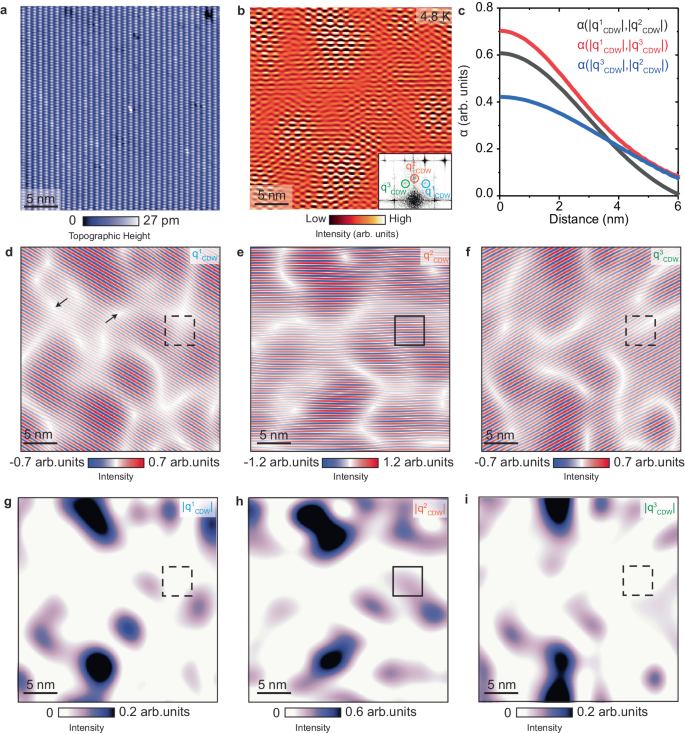
a STM topograph and ( b ) filtered integrated d I /d V map (adding 4 layers acquired at 35 mV, 40 mV, 45 mV and 50 mV) over the (0−11) surface of UTe 2 . Fourier filtering is done by removing all wave vectors except 9 pixel diameter centered at each q 1 CDW , q 2 CDW and q 3 CDW . Inset in ( b ) is the relevant portion of the Fourier transform of the integrated d I /d V map, with CDW peaks circled in blue, red and green. c Cross-correlation coefficients between the three CDW amplitude maps shown in ( g – i ). d – f Fourier filtered maps extracted from ( a ) by selectively keeping only a narrow circular FT window centered at ( d ) q 1 CDW , ( e ) q 2 CDW and ( f ) q 3 CDW . Two arrows in ( d ) point to apparent dislocations that routinely appear in the areas of low CDW amplitude. g – i CDW amplitude maps extracted from corresponding images in ( d – f ), showing the local height of each CDW wave vector. Black squares in ( d – i ) mark the same position on the sample with strong (solid line) and weak (dashed line) modulations. STM setup conditions: V sample = 50 mV, I set = 300 pA, V exc = 10 mV.
To gain further insight, we examine Fourier-filtered d I /d V maps of each individual CDW peak separately: q 1 CDW (Fig. 3d ), q 2 CDW (Fig. 3e ) and q 3 CDW (Fig. 3f ). In the filtering process, we again select a small FT window that encompasses each individual CDW peak. We note that the overall distribution of regions where CDW is strong vs weak in our data appears comparable regardless of small variations of the filtering window size (more details on the validity of the window size can be found in Supplementary Fig. 1 ). To quantify its local strength, we plot the intensity of each CDW peak |q i CDW | (where i = 1, 2 or 3) as a function of position to create CDW amplitude maps (Fig. 3g–i ). Our first observation is that all amplitude maps show a high level of spatial inhomogeneity, with local regions showing strong modulations dispersed within the larger matrix in which the modulations are substantially weaker. The amplitude maps of the two wave vectors related by the mirror symmetry along the y -axis, q 1 CDW and q 3 CDW, exhibit a remarkable similarity with a very high cross-correlation coefficient α ≈ 0.7 (Fig. 3c ). Similar cross-correlation coefficients are observed between maps obtained using different sizes of the Fourier filter window (Supplementary Fig. 1 ). Cross-correlation between the amplitude map of the remaining wave vector, |q 2 CDW | , and |q 1 CDW | (or |q 3 CDW | ) is also significant, although somewhat lower (Fig. 3c ), suggesting a slightly different morphology of domains. This can be visualized by examining the maps in real space, where we can for example find regions of high |q 2 CDW | , but low |q 1 CDW | and |q 3 CDW | (black squares in Fig. 3d–i ). This observation suggests a surprising local decoupling of individual density waves, where q 2 CDW becomes decoupled from mirror-symmetric q 1 CDW and q 3 CDW . This decoupling is further supported by examining the FTs of d I /d V maps at 10 K – q 2 CDW wave vector is still present while the other two, which were prominent at 4.8 K, are now completely suppressed (Fig. 2e–m ).
To evaluate the spatial evolution of the CDW order towards T CDW , we turn to the temperature dependence of the CDW amplitude maps (Fig. 4 ). For ease of comparison, we apply the Lawler-Fujita drift correction algorithm 21 to all d I /d V maps, which enables us to align data acquired at different temperatures with atomic precision. This process also allows us to systematically apply an identical q -space Fourier filter across all maps examined. For simplicity, we first focus on the q 1 CDW peak. Visual comparison of the data sequence from 4.9 K to 6.5 K (Fig. 4a–c ) reveals that nanoscale regions where CDW is the most prominent at 4.9 K remain generally the same at the higher temperature. However, amplitude within these nanoscale regions has decreased leading to the appearance that they have shrunk (Fig. 4d–f ), consistent with the global suppression of CDW in Fig. 2 . Cooling the system back down to the starting temperature of 4.9 K yields the CDW amplitude maps that are virtually indistinguishable from those before the thermal cycle (Fig. 4h ). Multiple consecutive thermal cycles paint the same picture of static CDW patches that get suppressed with temperature and expand again upon cooling down (Fig. 4h ). The striking similarity of the locations of CDW patches at different temperature is confirmed by the high cross-correlation coefficient (Fig. 4g ).
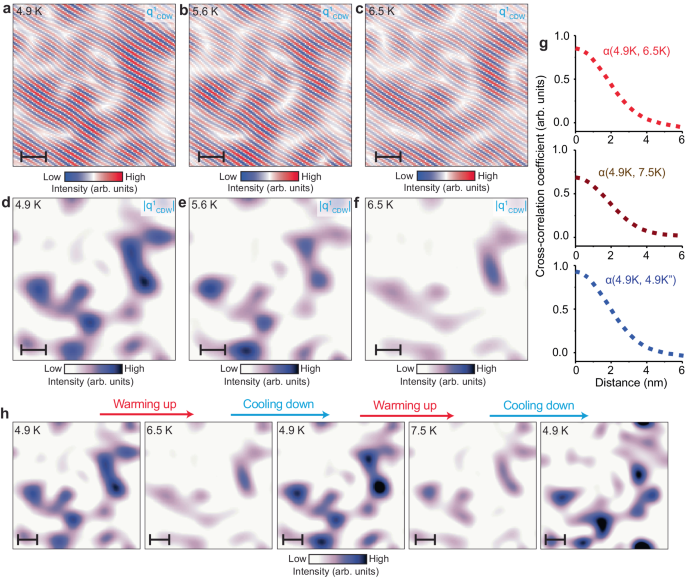
a – c Fourier filtered dI/dV maps showing the temperature dependence of the inhomogeneity of q 1 CDW , and ( d – f ) associated amplitude maps. g Radially-averaged cross-correlation coefficient α between pairs of different amplitude maps: α(4.9 K, 6.5 K) (red, top curve), α(4.9 K, 7.5 K) (brown, middle curve), and α(4.9 K, 4.9 K”) (blue, bottom curve). Here, 4.9 K” indicates the second cooling to 4.9 K after warming up to 6.5 K. h Thermal cycling sequence of amplitude maps associated with q 1 CDW taken at the same STM setup conditions. The scale bar in all images is 3 nm. STM setup condition: V sample = 40 mV, V exc = 100 mV, I set = 160 pA.
Complementary to temperature dependence, we study if CDW can be suppressed by magnetic field. Previous experiments revealed an intriguing suppression of the CDW in the superconducting state coinciding with the suppression of superconductivity, suggesting an intimate connection between the two 18 . Here we apply magnetic field at 4.8 K, well above the superconducting transition of UTe 2 . The field is applied at 3 degrees with respect to the direction perpendicular to the sample surface (Fig. 5a, b ). We find that the height of CDW peaks slowly decreases with applied magnetic field (Fig. 5c–f ). For example, q 1 CDW lowers by about 35% from 0 T to 11 T, but remains well above the background (Fig. 5c, e ). This suggests a critical field substantially higher than 11 T. The trend is remarkably consistent with the CDW evolution in the superconducting state 18 , although we are in the temperature regime that is three times higher than superconducting T SC . To gain spatial information, we extract CDW amplitude maps as a function of magnetic field similarly to our analysis in Figs. 3 and 4 . This analysis leads us to two main conclusions. First, CDW patches are again suppressed by the shrinkage of local regions (Fig. 5g, h ). Second, CDW puddles revert back to the original morphology after the field is removed (Fig. 5g, h ).
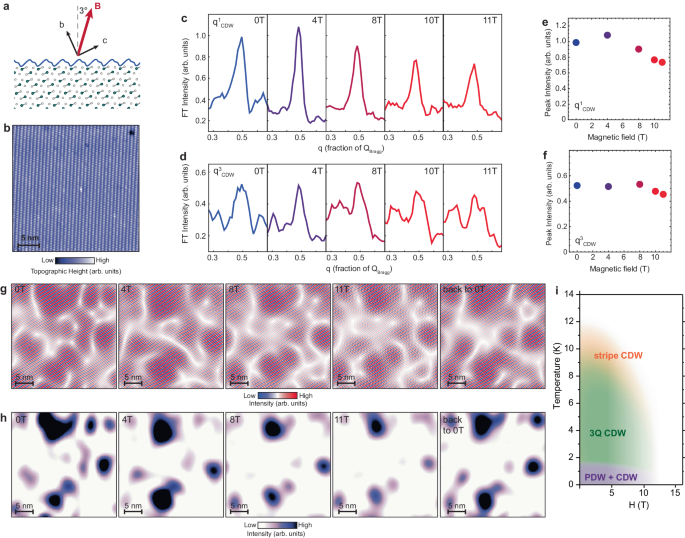
a Schematic of the magnetic field direction applied at 3 degrees with respect to the direction perpendicular to the sample surface imaged by STM. This small misalignment is due to accidental sample tilt during the gluing process, and it is determined from the background slope in raw STM topographs. b STM topograph of the region of the sample where the data were taken. c , d Fourier transform (FT) linecuts from the center of the dI/dV map FT through ( c ) q 1 CDW and ( d ) q 3 CDW peaks as a function of magnetic field. Sensitivity of the peak heights to large magnetic fields is observed. ( e , f ) Peak heights extracted from ( c , d ) plotted as a function of magnetic field. g Fourier filtered d I /d V maps including only the q 1 CDW peak (encompassing a 9 pixel diameter around the peak center), and ( h ) associated amplitude maps. i Approximate temperature vs magnetic field schematic phase diagram of density waves in UTe 2 . Here, “3Q CDW” refers to the charge density wave phase which includes all 3 directions: q 1 CDW , q 2 CDW , and q 3 CDW . “PDW” refers to the pair density wave phase. STM setup condition: V sample = −50 mV, I set = 300 pA, V exc = 10 mV. Data were taken at 4.8 K.
Our work reveals how intertwined density waves in a rare spin-triplet superconductor UTe 2 get suppressed with temperature, by first forming short-range nanoscale regions with charge modulations embedded within areas where modulations can no longer be observed. Interestingly, we find that the three CDW wave vectors locally decouple. Based on the energy-dependence and the temperature-suppression, we conclude that q 2 CDW along the mirror symmetry axis is distinct compared to the other two wave vectors. This in turn suggests a superposition of at least two independent density waves: unidirectional, or “smectic”, density wave associated with q 2 CDW and a bi-directional combination of mirror-symmetric q 1 CDW and q 3 CDW . It is possible that q 1 CDW and q 3 CDW would also behave as individual smectic density waves given the different magnetic field dependence reported in ref. 18 , although as we discover in Fig. 3 , they appear to be spatially intertwined. We note that vortex-like discontinuities seen between regions with strong modulations in Fourier filtered data, also recently reported in ref. 22 (examples of two such features rotated by π with respect to each other are denoted by arrows in Fig. 3d ) can dramatically change depending on the size of the filtering window as CDW peaks become less prominent. Moreover, these features routinely appear in the Fourier-filtered data of spatially inhomogeneous orders in other systems (Supplementary Fig. 2 ). Lastly, as these discontinuities always appear in regions with near-zero amplitude of the order parameter, which is generally below the FT noise threshold, we disregard them in our analysis.
Our experiments also reveal a remarkable repeatability of the morphology of nanoscale CDW regions by magnetic field or temperature cycling. In many materials, atomic-scale crystal imperfections are often responsible for electronic inhomogeneity 23 , 24 , 25 . Future experiments should explore to what extent accidental impurities or defects could account for the fragmentation or pinning of the charge modulations. This would be especially important to determine given the variation in the properties of nominally stoichiometric crystals of UTe 2 , where chemical inhomogeneity could be the natural culprit but defects responsible for this are yet to be identified.
Magnetic field and temperature suppression of the density waves provides narrow constraints on their origin. One possibility could come from a primary PDW. PDWs have now been observed in various materials as periodic modulations of the superconducting gap magnitude and coherence peak heights 2 , 3 , 5 , 7 , 19 ; these density waves naturally get suppressed with temperature as superconductivity is destroyed, possibly leaving a CDW slightly above the superconducting transition. We however find that the CDW persists to a temperature that is almost an order of magnitude higher than the superconducting T SC , which would be surprising for a “remnant” CDW phase. The possibility of a primary PDW in UTe 2 , which melts into a CDW above T sc , was largely supported by the critical magnetic field of the CDW comparable to that of the superconducting critical fields 18 . In our experiments, we find that similarly high magnetic fields are necessary and can be used to suppress CDW well above T sc (Fig. 5 ), thus making the immediate connection to superconductivity less obvious. So while a secondary PDW state can still emerge in the superconducting phase, our experiments point towards an unusual primary CDW phase forming well outside the superconducting state.
In general, magnetic field tunable CDWs reported in literature are extremely rare. Prominent examples include field-tunable CDWs in high-temperature superconductor YBa 2 Cu 3 O 7-x 26 and moiré graphene 27 , but both of these are phenomenologically different from that in UTe 2 . In YBa 2 Cu 3 O 7-x , CDW can only be modified by magnetic field in the superconducting state 26 , signaling a direct competition between the two; in contrast in UTe 2 , CDW is suppressed seemingly unrelated if the material is superconducting or not. In moiré graphene, CDW tunability can be directly tied to the gradual crossing of a Landau level through the Fermi level 27 , a physical regime entirely different from UTe 2 . This points towards a different mechanism of the CDW in UTe 2 , distinct from the select few other field-tunable CDWs in quantum materials.
Our SI-STM data, which reveal a new 10–12 K temperature scale associated with density waves, provide a fresh clue. Both thermal expansion coefficient data 28 and resistivity measurements 29 reveal features in their data near the same temperature. In particular, a recent pressure study demonstrates that this resistivity feature coincides with the eventual stabilization of the long-range magnetic order; as such, it is attributed to a magnetic energy scale indicative of magnetic fluctuations or a short-range magnetic order 29 . This could provide a plausible link between surface detection of density waves and bulk experiments. This connection, combined with magnetic-field sensitivity of the charge modulations in both superconducting 18 and non-superconducting states (Fig. 5 ), could point towards the origin of charge modulations in an underlying spin mechanism, without long-range magnetic ordering, which should be tested more directly in future spin-sensitive experiments.
Bulk single crystals of UTe 2 are grown by the chemical vapor transport method using iodine as the transport agent, with elements of U and Te (atomic ratio 2:3) sealed in an evacuated quartz tube, together with iodine. More details can be found in ref. 10 . UTe 2 crystals are transported from NIST to BC in a sealed glass vile filled with inert gas to prevent air degradation. The vile is opened in an argon glove box at BC, where the sample is glued to an STM sample holder, and a cleave bar is then attached to the sample using silver epoxy. We transfer the prepared sample from the glove box to an ultra-high vacuum load lock within seconds, and cold-cleave it before putting it into the microscope. STM data were acquired using a customized Unisoku USM1300. Spectroscopic measurements were performed using a standard lock-in technique with 910 Hz frequency. The STM tips used were home-made chemically etched tungsten tips. For the ease of comparison of data acquired at different temperatures and to standardize the Fourier filter windows applied in the analysis, we apply the Lawler–Fujita drift-correction algorithm 21 to our data. This process shifts and aligns the atomic Bragg peaks to be confined to the same individual pixels. Identification of commercial equipment does not imply endorsement by NIST.
Code availability
The computer code used for data analysis is available upon request from the corresponding authors.
Data availability
The STM data generated in this study have been deposited in the Zenodo database under accession code 11176886 .
Fradkin, E., Kivelson, S. A. & Tranquada, J. M. Colloquium: Theory of intertwined orders in high temperature superconductors. Rev. Mod. Phys. 87 , 457–482 (2015).
Article ADS CAS Google Scholar
Hamidian, M. H. et al. Detection of a Cooper-pair density wave in Bi 2 Sr 2 CaCu 2 O 8+x . Nature 532 , 343–347 (2016).
Article ADS CAS PubMed Google Scholar
Ruan, W. et al. Visualization of the periodic modulation of Cooper pairing in a cuprate superconductor. Nat. Phys. 14 , 1178–1182 (2018).
Article CAS Google Scholar
Edkins, S. D. et al. Magnetic field–induced pair density wave state in the cuprate vortex halo. Science 364 , 976–980 (2019).
Zhao, H. et al. Smectic pair-density-wave order in EuRbFe 4 As 4 . Nature 618 , 940–945 (2023).
Liu, Y. et al. Pair density wave state in a monolayer high-Tc iron-based superconductor. Nature 618 , 934–939 (2023).
Chen, H. et al. Roton pair density wave in a strong-coupling kagome superconductor. Nature 599 , 222–228 (2021).
Zhao, H. et al. Cascade of correlated electron states in the kagome superconductor CsV 3 Sb 5 . Nature 599 , 216–221 (2021).
Li, H. et al. Small fermi pockets intertwined with charge stripes and pair density wave order in a Kagome superconductor. Phys. Rev. X 13 , 031030 (2023).
CAS Google Scholar
Ran, S. et al. Nearly ferromagnetic spin-triplet superconductivity. Science 365 , 684–687 (2019).
Aoki, D. et al. Unconventional superconductivity in UTe 2 . J. Phys.: Condens. Matter 34 , 243002 (2022).
ADS CAS Google Scholar
Hayes, I. M. et al. Multicomponent superconducting order parameter in UTe 2 . Science 373 , 797–801 (2021).
Sundar, S. et al. Coexistence of ferromagnetic fluctuations and superconductivity in the actinide superconductor UTe 2 . Phys. Rev. B 100 , 140502 (2019).
Duan, C. et al. Resonance from antiferromagnetic spin fluctuations for superconductivity in UTe 2 . Nature 600 , 636–640 (2021).
Thomas, S. M. et al. Evidence for a pressure-induced antiferromagnetic quantum critical point in intermediate-valence UTe 2 . Sci. Adv. 6 , 1–8 (2020).
Article MathSciNet Google Scholar
Nakamine, G. et al. Superconducting properties of heavy fermion UTe 2 revealed by 125 Te-nuclear magnetic resonance. J. Phys. Soc. Jpn. 88 , 113703 (2019).
Article ADS Google Scholar
Ran, S. et al. Extreme magnetic field-boosted superconductivity. Nat. Phys. 15 , 1250–1254 (2019).
Aishwarya, A. et al. Magnetic-field-sensitive charge density waves in the superconductor UTe 2 . Nature 618 , 928–933 (2023).
Gu, Q. et al. Detection of a pair density wave state in UTe 2 . Nature 618 , 921–927 (2023).
Article ADS CAS PubMed PubMed Central Google Scholar
Jiao, L. et al. Chiral superconductivity in heavy-fermion metal UTe 2 . Nature 579 , 523–527 (2020).
Lawler, M. J. et al. Intra-unit-cell electronic nematicity of the high-T c copper-oxide pseudogap states. Nature 466 , 347–351 (2010).
Aishwarya, A. et al. Visualizing the melting of the charge density wave in UTe 2 by generation of pairs of topological defects with opposite winding. Nat. Phys. https://doi.org/10.48550/arXiv.2306.09423 (2024).
Zeljkovic, I. et al. Imaging the impact of single oxygen atoms on superconducting Bi 2+y Sr 2-y CaCu 2 O 8+x . Science 337 , 320–323 (2012).
Zeljkovic, I. & Hoffman, J. E. Interplay of chemical disorder and electronic inhomogeneity in unconventional superconductors. Phys. Chem. Chem. Phys. 15 , 13462–13478 (2013).
Article CAS PubMed Google Scholar
Zhao, H. et al. Imaging antiferromagnetic domain fluctuations and the effect of atomic scale disorder in a doped spin-orbit Mott insulator. Sci. Adv. 7 , abi6468 (2021).
Gerber, S. et al. Three-dimensional charge density wave order in YBa 2 Cu 3 O 6.67 at high magnetic fields. Science (1979) 350 , 949–952 (2015).
Kometter, C. R. et al. Hofstadter states and re-entrant charge order in a semiconductor moiré lattice. Nat. Phys. 19 , 1861–1867 (2023).
Thomas, S. M. et al. Spatially inhomogeneous superconductivity in UTe 2 . Phys. Rev. B 104 , 224501 (2021).
Kim, H. et al. Tuning a magnetic energy scale with pressure in UTe 2 . Preprint at https://arxiv.org/abs/2307.00180 (2023).
Download references
Acknowledgements
We thank Johnpierre Paglione for useful discussions. I.Z. gratefully acknowledges the support from DOE Early Career Award DE-SC0020130 for STM measurements. Z.W. acknowledges the support of U.S. Department of Energy, Basic Energy Sciences Grant No. DE-FG02-99ER45747 and the Cottrell SEED Award No. 27856 from Research Corporation for Science Advancement. Sample synthesis and characterization were supported by the National Science Foundation under the Division of Materials Research Grant NSF-DMR 2105191.
Author information
These authors contributed equally: Alexander LaFleur, Hong Li.
Authors and Affiliations
Department of Physics, Boston College, Chestnut Hill, MA, USA
Alexander LaFleur, Hong Li, Muxian Xu, Siyu Cheng, Ziqiang Wang & Ilija Zeljkovic
NIST Center for Neutron Research, National Institute of Standards and Technology, Gaithersburg, MD, USA
Corey E. Frank & Nicholas P. Butch
Maryland Quantum Materials Center, Department of Physics, University of Maryland, College Park, MD, USA
Nicholas P. Butch
You can also search for this author in PubMed Google Scholar
Contributions
A.L. and H.L. performed the STM experiments and analyzed the data with the help from M.X. and S.C. C.E.F. synthesized and characterized the samples under the supervision of N.P.B. Z.W. provided theoretical input on the interpretation of STM data. A.L, H.L., N.P.B., Z.W. and I.Z. wrote the paper with the input from all the authors. I.Z. supervised the project.
Corresponding author
Correspondence to Ilija Zeljkovic .
Ethics declarations
Competing interests.
The authors declare no competing interests.
Peer review
Peer review information.
Nature Communications thanks Yukio Hasegawa and the other, anonymous, reviewer(s) for their contribution to the peer review of this work. A peer review file is available.
Additional information
Publisher’s note Springer Nature remains neutral with regard to jurisdictional claims in published maps and institutional affiliations.
Supplementary information
Supplementary information, peer review file, rights and permissions.
Open Access This article is licensed under a Creative Commons Attribution 4.0 International License, which permits use, sharing, adaptation, distribution and reproduction in any medium or format, as long as you give appropriate credit to the original author(s) and the source, provide a link to the Creative Commons licence, and indicate if changes were made. The images or other third party material in this article are included in the article’s Creative Commons licence, unless indicated otherwise in a credit line to the material. If material is not included in the article’s Creative Commons licence and your intended use is not permitted by statutory regulation or exceeds the permitted use, you will need to obtain permission directly from the copyright holder. To view a copy of this licence, visit http://creativecommons.org/licenses/by/4.0/ .
Reprints and permissions
About this article
Cite this article.
LaFleur, A., Li, H., Frank, C.E. et al. Inhomogeneous high temperature melting and decoupling of charge density waves in spin-triplet superconductor UTe 2 . Nat Commun 15 , 4456 (2024). https://doi.org/10.1038/s41467-024-48844-7
Download citation
Received : 13 April 2024
Accepted : 15 May 2024
Published : 25 May 2024
DOI : https://doi.org/10.1038/s41467-024-48844-7
Share this article
Anyone you share the following link with will be able to read this content:
Sorry, a shareable link is not currently available for this article.
Provided by the Springer Nature SharedIt content-sharing initiative
By submitting a comment you agree to abide by our Terms and Community Guidelines . If you find something abusive or that does not comply with our terms or guidelines please flag it as inappropriate.
Quick links
- Explore articles by subject
- Guide to authors
- Editorial policies
Sign up for the Nature Briefing newsletter — what matters in science, free to your inbox daily.

Yankees MiLB Report (5/27): Rising pitchers, MLB-ready slugger, and wave of promotions
T he New York Yankees had another successful week at the Major League level, splitting a series against the Seattle Mariners and taking a series on the road in San Diego. At the Minor League level, there were plenty of fun performances over the past week, and we’re going to have full-week action from the Florida Complex League to Triple-A as we cover the bases with their farm system. With some incredible performances on the mound and in the batter’s box, we try to highlight the top performers at each level and keep you up to date on what’s going on around the farm.
FCL Yankees Are Eyeing First Place After a Strong Week
The constants of life are death, taxes, and the FCL Yankees playing great baseball. A 4-1 week would propel them right back into the conversation for first place in the division, and a huge part of that has been both the pitching and hitting clicking at the same time. Danny Flatt fired 4.2 innings of shutout baseball with six strikeouts and two walks, and the right-hander has a 1.42 ERA and 27.8% strikeout rate in his first three appearances of the season.
Command has been an issue, walking 13% of batters faced, but he’s only 19 years old and this is his first season at the professional level. After getting crushed in his second start of the season, Jordarlin Mendoza was electric this week, pitching 7.2 innings of one-run baseball with 12 strikeouts to four walks. He has a 3.29 ERA on the season and a 61.3% groundball rate to go with a 32.9% strikeout rate in his first four appearances.
On the offensive side of the ball, outfielder Brian Sanchez is off to an excellent start with a 176 wRC+ on the season, and he put up a 1.311 OPS this past week. He’s walking 13.7% of the time with a modest 23.5% strikeout rate in his first 13 games in the FCL, and the Yankees acquired the 19-year-old in the deal that sent Jake Bauers to the Brewers. Edgleen Perez, who just turned 18 years old this past weekend, is sitting pretty with an 181 wRC+ and .521 OBP through his first 12 games in the FCL as well.
Brando Mayea played his first week of games, posting a 109 wRC+ and .400 OBP through his first five contests but also striking out 30% of the time. It’s very early, but he’s a name that could become a top-100 prospect, so keep tabs on how well he does at this level.
It was a 4-1 week for the FCL Yankees, who will hope to get themselves into first place at some point this week if they can keep the ball rolling.
Tampa Tarpons Start To Get on a Roll Thanks To Brilliant Starts
The Tampa Tarpons, who struggled to get consistent pitching all season, are on an absolute roll with their rotation, as a strong trio is starting to emerge at the top of their rotation. Cade Smith, the Yankees’ sixth-round pick in the 2023 Draft, fired 7 shutout innings with two hits, two walks, and five strikeouts as he lowered his ERA to 2.41. His 30.1% strikeout rate and .172 AVG against are excellent, and while the walk rate is a bit high (11.8%), he’s mixed in more of his curveballs and changeups and has found ways to get more outs and pitch deeper into starts.
He boasts a 92-94 MPH fastball with good ride from a low slot, and his breaking balls are some of the nastiest in the organization thanks to his release heights and movement profiles. Luis Serna threw 5.1 innings of one-run baseball, striking out seven batters and walking one as he’s starting to find his groove on the mound. He started his season with a very ugly 10.32 ERA through his first three starts, but since then he’s pitched to a 1.74 ERA with a miniscule .6% walk rate.
Serna is throwing more of his nasty changeups, a pitch that I think is truly one of the best secondaries in baseball. With a 50% Whiff Rate and .178 wOBA, it absolutely overpowers opposing hitters regardless of the matchup. The most impressive pitcher this week arguably was Allen Facundo, who struck out 11 batters over five scoreless innings, and the key for him has been a slider that’s utterly dominant. It has a 67.2% Whiff Rate on the season, and Facundo has started to tear up the Florida State League in recent starts.
Over his last four starts, he has a 39.7% strikeout rate and 6.4% walk rate, posting a 2.41 ERA and 2.38 FIP in that timespan and the 21-year-old lefty could be in Hudson Valley soon (as could all three pitchers mentioned). The offense was not particularly great, but George Lombard Jr. picked up some hits and had a 119 wRC+ through the week. They went 4-2 and won the series, and they’ll hope to keep the ball rolling after an ugly start to their season.
Hudson Valley Scuffles in Brooklyn Road Trip
The Hudson Valley Renegades took a series loss to the Brooklyn Cyclones on the road, as they struggled on both sides of the ball. Cam Schlittler, who has been their best pitcher all season, was impressive once again in two starts as he allowed one run over 9.2 innings, striking out 13 batters. Walks are a problem for him, as he’s walked 11.7% of batters faced, but his high groundball rate (54.7%) and he’s showing off a brilliant breaking ball to go alongside his cutter.
Rafael Flores has really stepped up and mashed, especially this past week where he had a .438 OBP and .855 OPS in Brooklyn. The right-handed hitting catcher was selected to the Spring Breakout Game, and he’s posted a 138 wRC+ and .386 OBP with excellent framing skills behind the plate. He’s 23 years old, so he’s a bit older than the average hitter at that level, but he could be the first catcher up to Somerset when one of Agustin Ramirez or Ben Rice get moved up a level.
Jesus Rodriguez, another catcher who has torn it up in Hudson Valley, had a 1.006 OPS this past week with four doubles, and his wRC+ on the season sits at 153. He’s an excellent all-around hitter and could be one of the more interesting prospects to look at since he’s Rule 5 eligible already and could be a trade piece to bolster a package in a deal. Rodriguez seems to have a legitimimate bat, so I think a team could value him even if he doesn’t stick behind the dish.
Somerset Drops a Series, Ben Rice Warms Back Up
It was not a great series for the Somerset Patriots, who took a 2-4 series loss on the road against the New Hampshire Fisher Cats. Ben Rice smashed three home runs and had a 1.262 OPS this week, and after hitting a rough slump, he’s brought his wRC+ on the season all the way up to 144. He’s slugging .490 and has improved walk rates while the strikeout rate is finally coming down, and could be an MLB option for the team at first base.
The problem is the lack of certainty that he could hold his own at first base consistently, because the bat looks more than ready for a call-up to at least Triple-A. Another standout performer from the past week was Zach Messinger, who struck out 8 batters over 5.2 innings, allowing two earned runs and walking just one batter. He has a 2.01 ERA and 22.5% K-BB% over his last four starts, and has lowered his ERA to 3.75 on the season.
Brock Selvidge had a strong start as well allowing just two runs over five innings, but he walked five batters in the process. He has an uncharacteristically high 11.5% walk rate in his first eight starts in Somerset, but he still has a strong 3.07 ERA and 3.64 FIP as he’s striking out 25.7% of batters faced with a 49.1% groundball rate. Selvidge is just 21 years old, and if he can find a way to get back in sync mechanically, he could find himself in Triple-A by season’s end.
Scranton Stumbles, Yankees Seeing Top Pitcher Slump Hard
With a 3-4 week, the Scranton RailRiders played some poor baseball this week, but they were bound to hit some sort of slide at some point during the year. Injuries are catching up to them, with Clayton Beeter on the IL and Caleb Durbin hitting the IL after being hit by a pitch. Durbin had a 1.571 OPS before getting hurt this week including a walkoff HR and four RBIs, and the organization views him very highly. He could be someone the Yankees promote at some point in 2025 to potentially fill-in at second base.
On the more negative side here; something is seriously wrong with Will Warren. After getting off to a great start 3.95 ERA, he’s allowed 30 runs in 17 innings, and it’s not clear what exactly is wrong here. Things have gone from good to atrocious in a hurry; and he’ll have to turn it around quick if he wants to maintain his status as one of the better pitchers in the organziation.
It wasn’t a pretty week for Scranton as a whole, who had multiple spot starters thanks to the aforementioned issues in their usually stout rotation, but massive credit to Baron Stuart who fired seven innings of one-run baseball for the RailRiders to help them stay afloat.

A new Covid variant has taken over, and experts predict a small summer wave
Disease experts anticipate a small uptick in Covid cases this summer, as a new variant spreads.

The KP.2 variant represents 28% of Covid infections in the U.S., up from just 6% in mid-April, according to data released Friday by the Centers for Disease Control and Prevention.
KP.2 became dominant at the end of April — meaning it accounts for the largest share of new cases — outpacing the JN.1 variant, which took over in the winter.
Some scientists collectively refer to KP.2 and another variant called KP.1.1, which shares the same key mutations, as “FLiRT” — a reference to their amino acid changes.
Both are descendants of JN.1, which is part of the omicron lineage, like all versions of the coronavirus that have gained dominance in the last couple of years.
But KP.2 has three additional mutations in its spike protein compared with JN.1, which disease experts said could make it easier for the virus to bypass protection from vaccines or prior infections.
“It looks like those additional mutations make it more immune evasive, so it’s not a surprise that it would then dominate,” said Dr. Dan Barouch, director of the Center for Virology and Vaccine Research at Beth Israel Deaconess Medical Center in Boston.
Laboratory research from Japan, which was published as a preprint and has not been peer-reviewed, suggests that the Covid vaccines currently recommended in the U.S. may be less effective against KP.2 than against JN.1.
However, KP.2 might be less efficient at infecting cells, the research suggests, which could mean that a higher dose of the virus would be needed to infect someone.
People who were infected with JN.1 should still have some protection against KP.2, experts said.
The CDC does not collect regular data on how Covid symptoms are evolving over time, so it’s hard to assess whether illnesses caused by KP.2 look any different. Covid symptoms have generally been consistent over the last two-plus years.
Experts predict a small rise in cases this summer
Covid cases have spiked every summer in the U.S. since 2020. If KP.2 continues to gain prevalence, that pattern may repeat — but not as dramatically, experts predict.
The U.S. is in a good place with Covid heading into the summer, according to Andrew Pekosz, a virologist at Johns Hopkins University. Hospitalizations reached record lows at the end of April, the last data available before the CDC stopped requiring hospitals to report Covid admissions numbers.
“We see a late summer, early fall surge of cases, and then we see a second surge of cases right around the Christmas holidays, the New Year,” Pekosz said. “That pattern has been sort of reproducing itself for a couple of years now. The important thing, though, is the magnitude of the cases has been consistently dropping.”
Several factors could help the KP.2 variant spread this summer. When the weather gets very warm, people tend to congregate indoors to escape the heat, creating new opportunities for transmission. Many people also haven’t been vaccinated recently; less than a quarter of U.S. adults have received the updated Covid shot.
“I think that there’s going to be a significantly large susceptible population out there, from that combination of waning immunity and viral evolution, that we’re going to see a number of cases this summer,” said Dr. Thomas Russo, chief of infectious diseases at the University at Buffalo Jacobs School of Medicine and Biomedical Sciences.
But he added that since most people have some immunity to Covid, it’s possible that “the wave won’t be as great” as in previous years.
Barouch said past summer waves have coincided with the arrival of new variants, so this year could be similar.
“The increases in the summertime have often been in the context of new variants, such as the original Delta wave, for example, or the BA.5 wave,” he said. “So I wouldn’t be surprised if there is another summertime surge.”
Will KP.2 affect vaccine recommendations?
KP.2’s rise creates questions for the public health experts who decide which variants to target with new Covid vaccines.
The Food and Drug Administration on Tuesday postponed an advisory committee meeting that was meant to decide which strains to include in the updated vaccine formula for the fall.
"We have recently observed shifts in the dominant circulating strains of SARS-CoV-2," an FDA spokesperson said. "The additional time will allow the agency to obtain more up-to-date surveillance data and other information on the circulating strains of SARS-CoV-2 to better inform the committee’s discussions and recommendations."
The most recent vaccine-related recommendations from the CDC came in February, when it suggested that people ages 65 and up should get an additional dose and younger people could consider one.
People who haven’t received the updated shot and feel like they need it "should get the vaccine that’s currently available,” Barouch said.
But Pekosz said people who are not immunocompromised could probably hold off until the fall.
“With case numbers being relatively low right now, I think the prudent thing is to try to wait till September and get the new formulation,” he said.
Aria Bendix is the breaking health reporter for NBC News Digital.

IMAGES
VIDEO
COMMENTS
7 Waves Yachting. 263 likes. 7 Waves Yachting is your partner for exclusive Yacht Charter, Maritime Services and Consulting in Pa
7 Waves Yachting Av de Gabriel Roca 36, Palma de Mallorca, 07014, Spain. Phone: + 49 174 34 28 646 Email: [email protected]. You might be interested in. 7 Waves Yachting currently operates 12 charter yachts in its fleet. Check availability of their boats and make an on-line reservation in yachting.com. Best price guarantee.
7 Waves Yachting ist Ihr Partner für Charter, Yachtkauf und -verkauf direkt auf Mallorca. Chartern Sie exklusive Motor- und Segelyachten direkt beim Flottenbetreiber. Wir bieten neue Yachten, meist Eignerversionen, mit Spitzenausstattung und individuelle Services. Und wir bieten Unterstützung beim Kauf und Verkauf.
7 Waves Yachting currently operates 5 charter yachts in its fleet and it has bases in Port de Mallorca, Marina Palma Cuarentena and Club Nautic Arenal. Yacht pick-up time is between 17:00 - 21:00 daily, and drop-off can be arranged between 09:00. However, the company requires the yacht to be returned to the base by 18:00 in the evening before ...
Operator 7 Waves Yachting has 6 yachts in his fleet. Home country of all operator's boat is Spain. and are available to charter in Mallorca - Port de Mallorca Marina, Mallorca - S`Arenal, ... Holidays on a yacht is a very good idea of spending you free time in a fine company, in interesting place and in an original way. ...
See more information about 7 Waves Yachting 🌊 Rent a yacht in Spain and have the best holiday ever ️ Book now and sail wherever you want ⛵ Yasido.com
Discover 7 Waves Yachting's fleet of 7 yachts, based in Marina Palma Cuarentena, Port de Mallorca and Club Nautic Arenal. Enjoy Refrigerator, Cooker and Kitchen utensils. Limited time offer Top sellers still available for summer 2024
7 Waves Yachting ist Ihr Partner für Charter, Yachtkauf und -verkauf direkt auf Mallorca. Chartern Sie exklusive Motor- und Segelyachten direkt beim Flottenbetreiber. Wir bieten neue Yachten, meist Eignerversionen, mit Spitzenausstattung und individuelle Services. Und wir bieten Unterstützung beim Kauf und Verkauf.
Find out more details about yacht charter company 7 Waves Yachting. Check their fleet of 4 boats, office details and even customer reviews.
Details of charter operator 7 Waves Yachting. Full name is 7 Waves Yachting. Here you can compare prices and charter yachts online
7 Waves Yachting · February 27, 2021 · Instagram · · February 27, 2021 · Instagram ·
The newest addition to our charter fleet - a Brand new #jeanneau #db43 - just arrived and is now being prepared for the season. Stay tuned to be among the first to enjoy our #BonVoyage #stpshipyard...
7 Waves Yachting - Facebook
7 Waves Yachting betreibt derzeit 13 Charteryachten in seiner Flotte. Überprüfen Sie die Verfügbarkeit ihrer Boote und nehmen Sie eine Online-Reservierung auf yachting.com vor. Bestpreisgarantie
7 Waves Yachting, Spain | GotoSailing. Sailing holiday in Croatia . Boat Rental in Croatia Sailing Yachts in Croatia Sailing Yachts in Croatia
Finding the right boat takes time. Leave it to us. Filter By recommendation By recommendation
7 Waves Yachting. 256 To se mi líbí · Mluví o tom (10). 7 Waves Yachting is your partner for exclusive Yacht Charter, Maritime Services and Consulting in Pa
The Tasty Waves is a 110' (33.53m) RIVA Motor Yacht available for charter, built in 2019. Prices range from $115,000 USD to $115,000 USD Per Week. Accommodation up to 11 guests. Contact your charter yacht broker to receive more charter details of the 110' (33.53m) RIVA Motor Yacht Tasty Waves available for charter today!
99 likes, 14 comments - anidrw_ on May 27, 2024: "Memories make waves one by one . . . #family #love #momlife #kids #smile #photooftheday #happy #instagood #fun #boat #yachting #boat...". ᴀɴɪʟᴀɴᴅʀᴇᴡ | Memories make waves one by one🌊 . . . #family #love #momlife #kids #smile #photooftheday #happy #instagood #fun #boat #yachting ...
Today, my Administration is canceling student debt for 160,000 more people, bringing the total number of Americans who have benefitted from our debt relief actions to 4.75 million. Each of those ...
7 Waves Yachting. 258 tykkäystä · 1 puhuu tästä. 7 Waves Yachting is your partner for exclusive Yacht Charter, Maritime Services and Consulting in Pa
7 Waves Yachting. 258 likes · 1 talking about this. 7 Waves Yachting is your partner for exclusive Yacht Charter, Maritime Services and Consulting in Pa
Wuthering Waves releases May 22, 2024 at 7 PM PT for PC, Android, and iOS and is available now for pre-download. To pre-load the game, you should go to the respective platform you want to play on ...
7 Waves Yachting ist Ihr Partner für Charter, Yachtkauf und -verkauf direkt auf Mallorca. Chartern Sie exklusive Motor- und Segelyachten direkt beim Flottenbetreiber. Wir bieten neue Yachten, meist Eignerversionen, mit Spitzenausstattung und individuelle Services. Und wir bieten Unterstützung beim Kauf und Verkauf.
PDWs have now been observed in various materials as periodic modulations of the superconducting gap magnitude and coherence peak heights 2,3,5,7,19; these density waves naturally get suppressed ...
STOUGHTON, Mass.—Eighth-grader Sandla Desir spoke softly in a classroom recently while reading the Dr. Seuss book, "One fish, two fish, red fish, blue fish," aloud in accented English. The ...
Cade Smith, the Yankees' sixth-round pick in the 2023 Draft, fired 7 shutout innings with two hits, two walks, and five strikeouts as he lowered his ERA to 2.41. His 30.1% strikeout rate and ...
May 23, 2024. 1 min to read. From NHC. Hurricane forecasters are tracking a tropical wave in the southwestern Atlantic Ocean, the second to form before the official start of the 2024 Atlantic ...
7 Waves Yachting. 256 ember kedveli · 15 ember beszél erről. 7 Waves Yachting is your partner for exclusive Yacht Charter, Maritime Services and Consulting in Pa
Experts predict a small rise in cases this summer. Covid cases have spiked every summer in the U.S. since 2020. If KP.2 continues to gain prevalence, that pattern may repeat — but not as ...